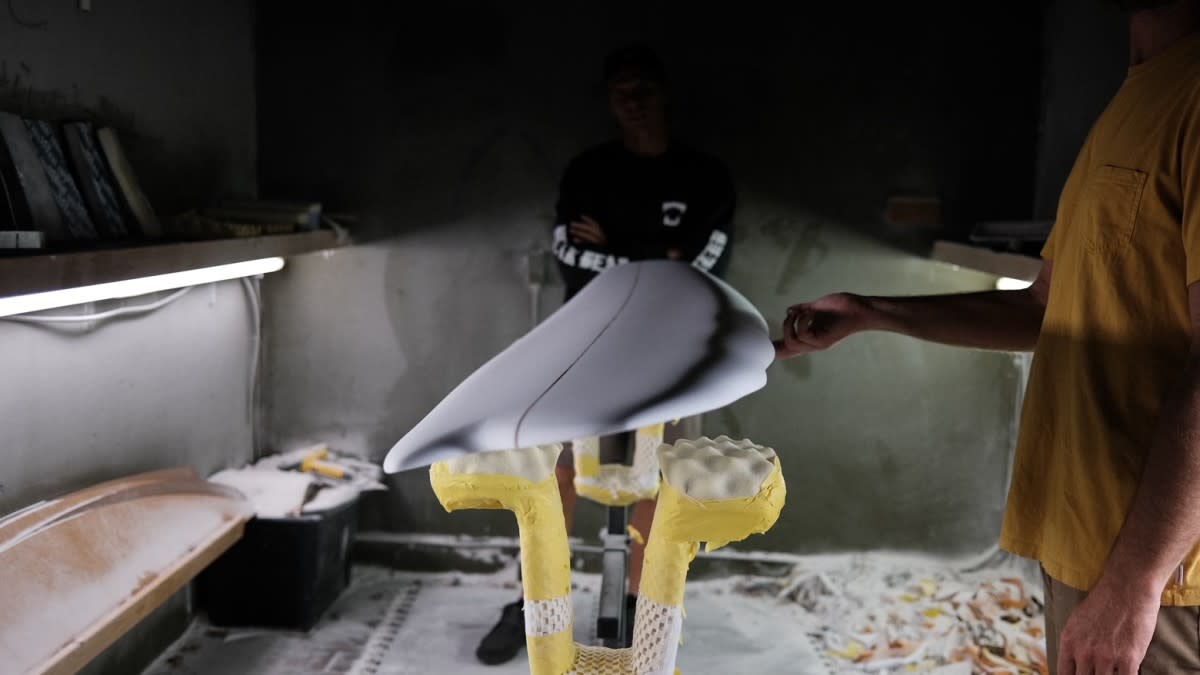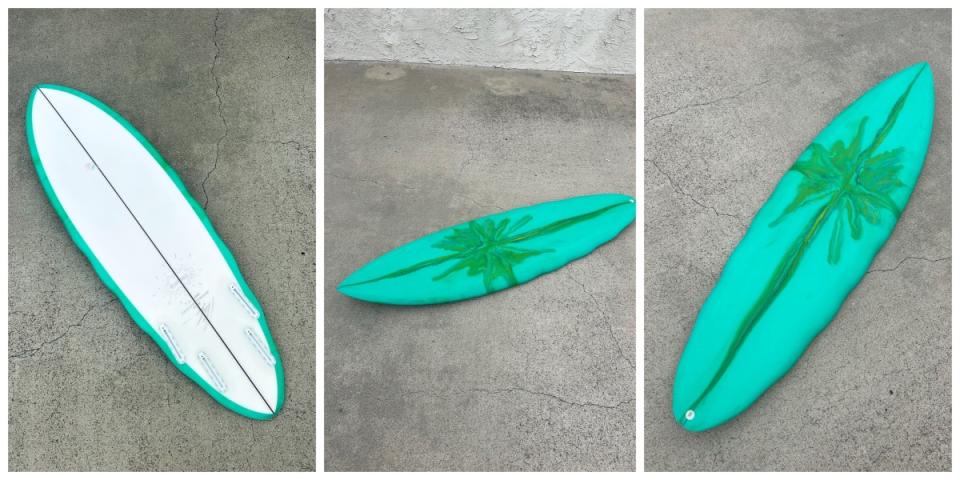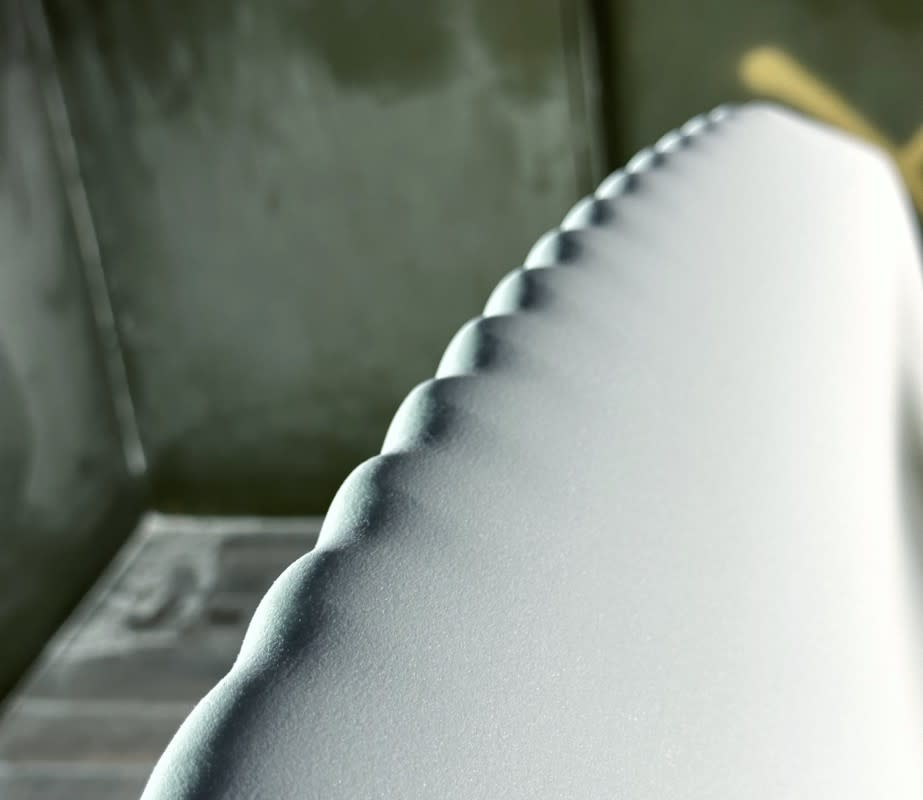Are Serrated Surfboards the Future? Koa Smith Thinks So.

Photo: Album Surfboards
Sir Isaac Newton, so the story goes, was sitting under a tree when he discovered gravity.
The famed physicist was relaxing in the shade sometime in the late 1600s, musing about what one does, the nature of the universe, when the answer to his questions presented itself in physical form. An apple, not falling to the earth, but rather being pulled by earth’s gravity.
It was the ultimate “a-ha” moment. And Koa Smith, Hawaiian-born free-surfer extraordinaire, recently had one of his own Newton-esque epiphanies when it comes to surfboard design, and particularly, the way boards cut through water. Or, in other words, they struggle to.
His tree? A serrated knife. His apple? A steak. His gravity? Surfing.
With the help of Matt Parker (of Album Surfboards fame), Koa’s creation came to life. And much to his surprise, during his inaugural test drive at Rocky Point, the serrated surfboard went shockingly well. So much so that we called up Koa to hear more. Keep reading for our chat.

Photo: Album
Take us back to the idea, the concept.
I’m a pretty front-footed surfer, and I have a hard time doing a really steep bottom turn. Sometimes I just have a hard time getting my front edge rail into the wave. I was thinking about that while I was eating a steak. My knife was cutting through the steak so easily. Those two thoughts combined and I was, like, ‘whoa. What if we created a serrated edge on your surfboard?’ The idea is that it will create multiple opportunities to break the surface tension.
What did Matt Parker say when you brought him the idea?
I forget the exact text, but it was something like: ‘Let’s do it.’ He was totally onboard. Later that day, he sent a 3D board model with a rough outline of it. Then the next day, he sent a photo of it already shaped. I was like, ‘oh my god, it’s actually happening.’
You mentioned only Laird [Hamilton] had done something similar previously?
How sick is that? I don’t know if he still has an existing model [he does] as a standup paddleboard, but you know Laird…he’s always thinking about what’s possible.
How was that first session at Rocky Point?
I was very surprised by how it felt. It was one of those situations [that] could be the best thing ever, or it could be the worst thing ever. It leaned towards being really good.
What I noticed is that, since I was riding it in pretty bumpy conditions, I felt that the rail was cutting through those chatters. I wasn’t feeling as much of the bump. And like my original thought, it felt like it allowed me to do a steeper bottom turn.
I think there’s definitely something there. It’s just a matter of refining it now.
We’re looking into another model with really small serrated edges. They almost look like tiger teeth. But the edges aren’t sharp; they’re rounded. So, instead of a two-to-three inch bump, it’s like a one-inch bump. We know there’s something to it, and now we’re trying to isolate that, and find the potential.
"Not everyone needs a 5’11” round-tail CT surfer board. Since I’ve realized that, I’ve been so much more psyched on surfing."
Do you think it would work in all types of waves, all styles of surfing?
To me, it was like, why isn’t this on all my boards? Especially with Pipe boards, bigger boards, even tow boards. The faster you go, the harder the surface tension. So, any help we can get to cut through that will be a big win. Now it’s like, let’s test it.
Equipment is so interesting when it comes to surfing. It really depends on who you are as a surfer. What I want to create with Matt is a board that allows you to do what you wanna do. If it’s high-lining, great; if it’s doing an air reverse, great. I wanna create the freedom for you to have more fun while you surf.

Photo: Album
What’s going on with Resonance Surf?
You’ve probably seen what Matt is doing with Coco. [Check out our interview with Coco Ho about her new board brand, XO Coco.] They realized that women are shaped differently, and that maybe they’re boards should be a little different. He came to me – I started riding his boards like a year ago – and he wanted to create our own little project. He knows that I’m very open to innovation and creativity, and he’s supporting me on that journey.
It's pretty unconventional, what we’re doing. As a traveling professional surfer, I need a certain quiver of boards that’s going to excite me from zero to 20 feet. So, the boards I’m going to be traveling with are always going to be changing. As a surfer, you’re always evolving when it comes to what’s under your feet. The models we make are going to be kind of limited. What’s available right now isn’t going to be available in a couple months.
"I think there’s a misunderstanding when it comes to riding these weird crafts. People think they suppress performance. I don’t think that’s true."
That puts us in a real cool position, in which we have complete freedom.
Less effort, more speed. That’s the idea. We want to slow down your surfing, and make the board do the work to gain speed. You don’t have to get it going, which is what it’s like on a conventional surfboard. I think there’s a misunderstanding when it comes to riding these weird crafts. People think they suppress performance. I don’t think that’s true. That’s our goal: Making these boards that allow for creativity and freedom in all conditions. Not everyone needs a 5’11” round-tail CT surfer board. Since I’ve realized that, I’ve been so much more psyched on surfing.
Now, no matter what the conditions, I’ve got the right tool for the job.
Are serrated surfboards the future?
I feel like it’s going to be a standard model that people are riding. The goal is to make it available to people soon. Resonance is launching soon, and these models will be available. We just want people to have more fun with their surfing, that’s all.
